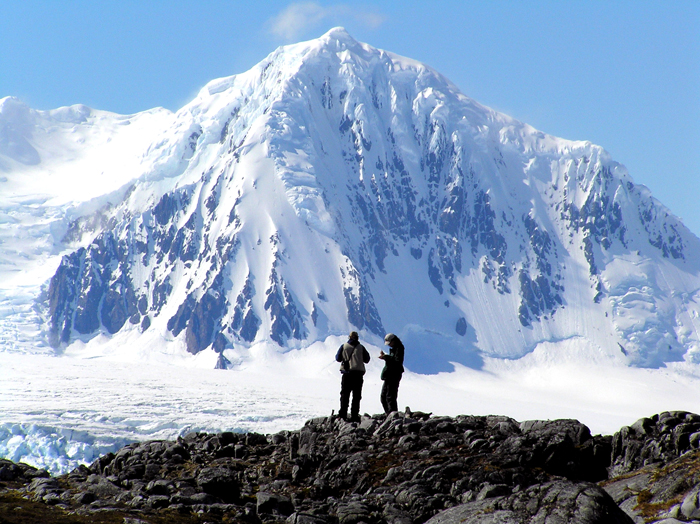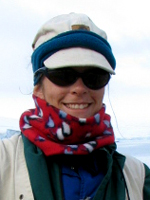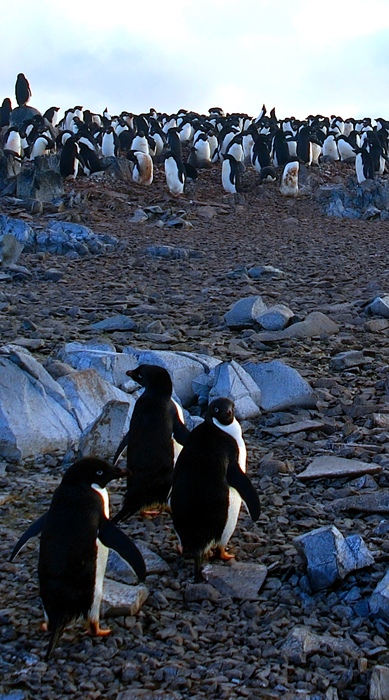
Photo Credit: Geoffrey Gilbert |
Researchers Heidi Geisz, right, and Dan Evans survey seabird populations in the Antarctic Peninsula. Geisz recently published a paper that says DDT levels in penguins aren't declining as they are elsewhere in other animal populations around the world. She and her co-authors believe glaciers store the chemical and release it as they melt into the ocean. |
Persistent chemical
Glaciers continue to release DDT into marine environment as they melt
By Peter Rejcek, Antarctic Sun Editor
Posted May 30, 2008
More than three decades after much of the world banned or restricted its use, the pesticide known as DDT is still showing up at consistent levels in the tissue of Adélie penguins in Antarctica.
That’s the finding recently published online in the journal Environmental Science & Technology by scientists studying ecosystem processes and climate change in the Antarctic Peninsula. They concluded that because most countries have banned or severely restricted DDT use since the 1970s, the source of the insecticide is most likely glacial meltwater.
The idea is that the chemical has been stored in the ice, but glaciers have transported it to the coast. The scientists estimate that glaciers are releasing 1 to 4 kilograms of DDT per year into coastal waters along the West Antarctic ice sheet.
The paper’s lead author, Heidi Geisz, a PhD student at Virginia Institute of Marine Science (VIMS), said the birds are probably not suffering any ill effects from the powerful insecticide based on levels the researchers found.
“We know that DDT can affect [seabird] reproductive systems and their endocrine systems … but these studies have not been done on Antarctic penguins,” she said. “The levels that we’re seeing in these penguins wouldn’t even be approaching levels where we’ve seen effects in other birds.”
However, Geisz said that DDT tends to occur with other persistent organic pollutants (POPs), such as polychlorinated biphenyls, better known as PCBs. These industrial chemicals were used in a number of products, from coolants to sealants, before being banned in the 1970s.
“We would like to do a long-term study on some of those other chemicals, such as PCBs, but the methods for investigating those chemicals have changed so much over the years it wouldn’t be reliable to compare current data to historical data, but DDT we were able to do that,” Geisz explained. “That’s why we chose DDT, not for any political reasons, it just happened to be the chemical for which we have reliable long-term data, but we know those other chemicals have been there and are still there.”

Photo Credit: Dan Evans
Heidi Geisz.

Photo Credit: Heidi Geisz
Adélie penguins.
First synthesized in 1874, DDT wasn’t used as an insecticide until around World War II, when it was employed to control mosquitoes spreading malaria and other diseases. Certain characteristics of DDT that contributed to its popularity, particularly its persistence, later caused public concern, according to a history of the chemical published by the U.S. Environmental Protection Agency.
Although scientists warned against its hazards as early as the mid-1940s, it was the publication of Rachel Carson’s book “Silent Spring” in 1962 that stimulated widespread concern over use of the chemical. DDT was blamed for thinning the eggshells of bald eagles and other birds, nearly leading to the extinction of the American icon. Ten years later, the EPA banned its use domestically.
On a side note: A 20-year study by NOAA scientists released in May showed that environmental laws enacted in the 1970s are having a positive effect on reducing overall contaminant levels in coastal waters of the United States. However, the report said elevated levels of metals and organic contaminants persist near urban and industrial areas of the coasts.
“It’s interesting to note that pesticides, such as DDT, and industrial chemicals, such as PCBs, show significant decreasing trends around the nation, but similar trends were not found for trace metals,” said Gunnar Lauenstein, manager of the NOAA Mussel Watch program. “What is of concern is that there are contaminants that continue to be problematic, including oil-related compounds from motor vehicles and shipping activities.”
NOAA’s Mussel Watch Program, founded in 1986, is the nation’s longest continuous national contaminant-monitoring program in U.S. coastal waters. The program keeps collected tissue samples frozen so that scientists can retroactively analyze overlooked or newly emerging contaminants.
The United States is one thing, but how did a contaminant used to kill mosquitoes end up on a continent virtually without any insects in the first place? Atmospheric circulation, Geisz said. The bottom of the food chain, phytoplankton, ingest the chemical as it enters the ecosystem. Krill eat the phytoplankton, and then larger predators gobble up the contaminated krill.
“It’s incorporated into the fat and lipid tissues of these animals, and it persists up the food chain,” Geisz explained. “You get a magnification effect in the higher predators like penguins.”
That magnification effect, called biomagnification, means chemicals like DDT do more damage the higher up the food chain they move. The chemicals are slow to break down, though DDT will eventually become a metabolite called DDE, which persists for even longer.
“We are talking about thousands of years for the ultimate breakdown,” Geisz said. “We have other professors [at VIMS] who have found this stuff in the deep sea. It’s everywhere.”
Geisz has helped with research in the Antarctic Peninsula area for eight seasons, focusing on the effects of climate change on seabirds with scientist and co-author Bill Fraser of the Polar Oceans Research Group. During that time she learned about a study Hugh Ducklow, now with the Marine Biological Laboratory in Woods Hole, Mass., and Rebecca Dickhut, chair of the Physical Sciences Department at VIMS, were doing on contaminants in phytoplankton and krill.
“I thought that was really interesting,” she said of the work by Ducklow and Dickhut, also co-authors on the journal paper. “We talked about looking at birds and starting a graduate program, and it sort of developed from there.”
NSF funded research in this story: Heidi Geisz and Rebecca Dickhut, Virginia Institute of Marine Science; Hugh Ducklow, Marine Biological Laboratory; and Bill Fraser, Polar Oceans Research Group.







